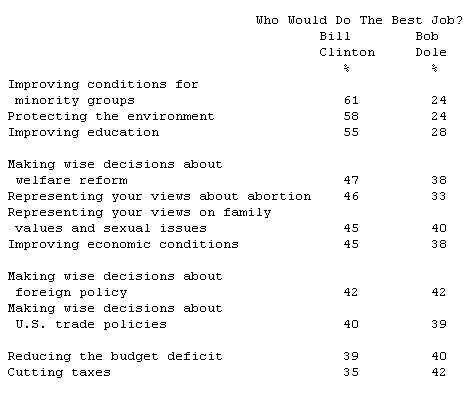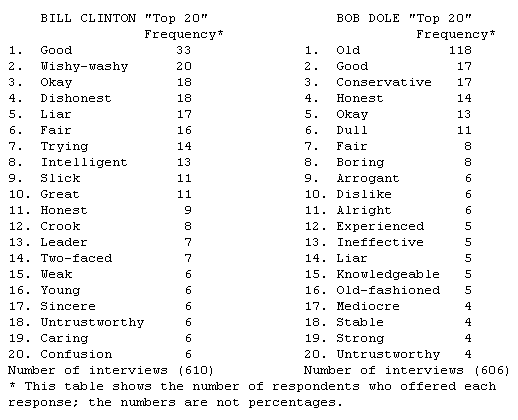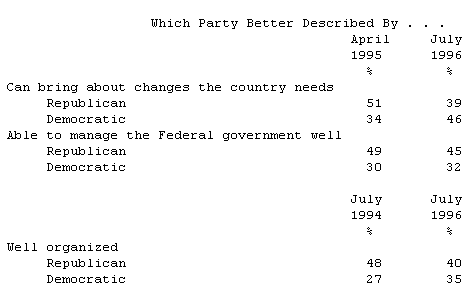Dole’s Door Still Open?
Clinton’s consistent margin over Dole and Perot notwithstanding, respondents in the Pew Research Center survey gave answers to a number of questions that indicate the potential for a closer contest. Only a minority of voters said they were strong supporters of either of the candidates — 20% for Clinton and 11% for Dole. Further, there is a sizable number of people — 15% of respondents registered to vote — who say there is a chance they might vote for Dole even though they now do not support him. Fewer, 8%, say they might change their minds in favor of front runner Clinton.
The survey also found that both candidates have a significant amount of negative support — votes based on dislike of their opponents — which is usually more subject to change than positive support. When Clinton supporters were asked the principal reason for their choice, 31% cited a criticism of Dole or some other negative factor about the Republicans. Fully 47% of Dole supporters expressed their dislike of Clinton rather than mentioning a positive reason for favoring Dole.
Dole’s seeming inability to give voters a positive reason to choose him is reflected in the way voters evaluated him in personal terms, compared to Clinton. By a margin of three-to-one, Clinton is judged more personally likable and as the candidate who connects well with ordinary Americans. Clinton is also selected significantly more often than Dole as having new ideas (49% to 28%), as sharing the respondent’s values (45% to 36%), as having good judgement in a crisis (47% to 35%), and as able to get things done (42% to 33%).
The former Senate majority leader is only evaluated more positively than the President for honesty and truthfulness (40% to 25%) and for keeping promises (35% to 29%). Dole has lost ground on a number of these dimensions since March, however. In the new poll smaller percentages selected him for having new ideas (28% to 34%), for his intelligence (29% to 35%), and for his ability to get things done (33% to 41%). President Clinton also received lower ratings in this poll than in March for being honest and truthful (25% to 34%), and “for caring about people like me” (48% to 54%).
It’s His Record, Stupid
But only a minority of voters, even among those who oppose Clinton, say that the charges about Clinton’s character are the most important basis for evaluating him. Among those inclined to vote for Clinton, 65% said his record is the most important factor in their judgment, 23% said he has prevented the GOP leaders in Congress from enacting their program, while only 8% cited character issues. Among Dole supporters, 38% mentioned Clinton’s character as the key to judging the President. An equal percentage (38%) consider Clinton’s record more important, while 19% mentioned his successful opposition to Republican legislative efforts as their basis for judgment.
The President has not only convinced many voters that he has a record of accomplishment, but has also blunted the GOP’s usual advantage on a number of issues. Respondents not only gave Clinton much more support than Dole on nominally “Democratic” issues, such as education, the environment and dealing with the problems of minority groups, but they were also evenly split between the two candidates on traditionally “Republican” issues such as a balanced budget, trade and foreign policy. Furthermore, small pluralities had more confidence in Clinton than Dole on two important Republican agenda issues, welfare reform and family values. Cutting taxes was the only issue on which more survey participants selected Dole over Clinton.

More of the Public’s Sound Bites
Asked what “one word” best describes each of the Presidential candidates and their wives, the public offered a mix of positive and negative terms for both of the Clintons, with especially strong negatives on the First Lady. About 84% of respondents were able to come up with a single word for the President and his wife.

Dole was most often described in terms of his age: 118 respondents volunteered the word “old” for the Republican candidate. Elizabeth Dole received mostly rosy reviews — but almost half of Americans (46%) said they did not know enough about her to give a response.

Improved Image for Democrats
Although there has not been a great shift in voting intentions toward the Democrats, the image of their party has improved strikingly in the eyes of the voters, particularly among Independents, in the past 15 months. The proportion of the public which believes that Democrats “can bring about the kind of changes the country needs” has risen 12 percentage points since April 1995, to 46%, while the Republican standing has fallen by the same amount, to 39%. More of the public also credits the Democrats with being “well organized” than previously: 35%, up from 27% two years ago. Republican stock has fallen here, too, from 48% to 40%, although the GOP remains marginally ahead on this measure.
Virtually all of the Democratic gains on the question of bringing about change the country needs were found among Independents: a 21 percentage point rise (from 28% to 49%) during the period. Moreover, Independents who lean Republican shifted almost as much in the same direction: a 16 percentage point rise (from 8% to 24%) in favor of the Democrats. On the question of which party is well organized, gains of similar size were found among the same two political groupings, Independents and Republican-leaning Independents. Demographically, the Democrats’ image on ability to bring about change improved most among middle-aged Americans and among men.

Another sign that the Republicans have lost their edge in public confidence was the disappearance of a 10 percentage point margin the GOP enjoyed last year on the question of which party can better handle the “most important problem” facing the nation. In April 1995, 42% of respondents said the GOP was better, 32% said the Democrats; now the two parties are statistically even at 36% and 35%, respectively. Leading the list of the most important problems was crime (cited by 19%), followed by morality/family values (13%), drugs/alcohol and dissatisfaction with the government/politics (both 8%), and unemployment, welfare abuse, and deficit/balanced budget (all 7%). Health care was a mere 4% compared to a high of 20% two years ago. Another notable finding was the continued drop in salience of economic issues among voters: from a high of 76% in January 1992 and 28% in June 1995, the total citations for all economic issues amounted to only 18% now.
Republicans continue to enjoy the same edge as in recent years as the party “able to manage the Federal government well:” 45% to 32% for Democrats. They have also retained their recent gains as the party “concerned with the needs of people like me,” 35% vs. 21% in 1990, although the Democrats at 50% are still most highly regarded on this score.
Other long-standing images of the two parties remained intact. Democrats are seen far more as the party “concerned with the needs and interests of the disadvantaged:” 63% vs. 23% for the GOP. The Republicans, for their part, are still seen as the party more “concerned with the needs and interests of business and other powerful groups:” 65% vs. 19% for Democrats. The parties received the same rating for being able to govern “in an honest and ethical way:” 38% GOP vs. 37% Democrats, with 18% of respondents saying “neither.”
Third Party Inclinations
Despite the apparent resurgence of Democrats, the electorate retains considerable interest in an alternative to Democrats and Republicans. A solid majority of 58% agreed the country should have a third party, up from 53% two years ago and from 41% in January 1984 (in an ABC/Washington Post poll). Among registered voters now, 44% said they favored Clinton outright or leaned toward him, 34% favored or leaned toward Dole, and 16% favored or leaned toward Ross Perot. This Perot support is down only slightly from two years ago when it stood at 20% (July 1994). On the other hand, when asked who they would prefer as the candidate of the Reform Party, its founder Perot or former Colorado governor Richard Lamm, 43% of all respondents chose Perot while 30% picked Lamm. However, among respondents who had heard of Lamm’s decision to run, the results were reversed: 40% chose Lamm and only 33% picked Perot. Independents informed of Lamm’s decision chose him 46% to 30%, and even among those who voted for Perot four years ago, Lamm was favored (albeit insignificantly) over Perot, 41% to 38%. Lamm’s support was strongest among whites, college graduates and those with incomes over $30,000 a year.
News Interest Rises with Tragedies, Games
[A full listing of News Interest Index results can be found on the Pew Research Center’s World Wide Web page: www.pewresearch.org/pewresearch-org/politics]
Similarly, the pipe bomb explosions at the Atlanta Olympic Games was followed very closely by 57% of the public, essentially identical to the 58% who did the same for the Oklahoma City bombing a year ago. The Games themselves were followed very closely by 45% of the public, compared to 33% who did the same for the Winter Olympic Games in 1992. The burning of black churches in the south was followed very closely by 35% of Americans, and the bombing of a U.S. military base in Saudi Arabia by 32%.
Women were a somewhat higher proportion of the news audience on the TWA and the two Olympic stories, but men were higher for the Saudi Arabia bombing. The Games, for example, were followed very closely by 47% of women, 42% of men. And reflecting the natural audience for athletic competition, 56% of Americans under 30 watched very closely (compared to 43% of the middle-aged and 40% of Americans 50 years old and older). Respondents in the eastern U.S. followed the TWA crash much more than those in other regions. Those living in the West followed the Olympic bombing more closely than other regions, perhaps reflecting the time differences with Atlanta; the bombing occurred after 1 a.m. EDT. Fully 67% of African Americans followed the church burnings very closely, more than twice the proportion of whites (31%).
Few Follow Filegate
Only 14% of Americans followed very closely news about the Whitewater investigation despite the release of a critical Senate committee report and the jailing of some former Clinton associates in Arkansas. This was only 3 percentage points above the lowest interest level in that subject, which came earlier this year when merely 11% followed such news very closely, and was only half of the 22% who followed it two years ago when the story was fresh. Essentially the same interest level, 15%, was also found now for news about the improper White House gathering of FBI files. Republicans were much more interested in Filegate than were Democrats and Independents. Among earlier Clinton controversies, news of the hiring of illegal aliens by Attorney General nominees Zoe Baird and Kimba Wood attracted 24% of the public, President Clinton’s $200 haircut got 18%, Paula Jones sex charges rated 15%, Clinton’s alleged extramarital affairs 15%, White House aide Vince Foster’s suicide 13%, the White House travel office firings 13%, and Clinton draft avoidance 11%.
Tobacco and Abortion Issues Visible
The public pronounced the presidential election campaign dull to date. Only 22% said they followed it very closely. Despite the low interest, however, the public was very aware of two highly contentious issues that emerged so far — abortion and tobacco. Three out of four Americans said they have either heard a lot (26%) or heard something (50%) about the debate over the Republican party’s platform on abortion. And more than two out of three Americans said they had heard a lot (33%) or something (35%) about Dole’s statement that cigarettes might not be addictive to everyone.
American interest in the former Soviet Union appears to have reached a new low. The breakup of the former Communist empire in October 1991 following the coup attempt against Mikhail Gorbachev attracted 47%, the high point of public attention. By 1993, only 18% followed Boris Yeltsin’s decision to dissolve the Russian Parliament. Now, merely 7% followed very closely news about Yeltsin’s reelection over an old-line Communist challenger. In other foreign news, 16% followed the situation in Bosnia very closely, down from a high of 37% in January of this year when U.S. forces were being introduced into that Balkan country.
Low Grades for the Press
Perhaps because the public finds the race boring, the media received only fair grades for covering the U.S. presidential campaign. Only 42% of the public rated the press “excellent” or “good” in doing its job, down from 61% at the height of the GOP primary fights in February 1996. And 42% rated the press “only fair” compared to 25% last February.
But the press was overwhelmingly rated as fair in its coverage of both Clinton and Dole. On Clinton’s campaign, 72% judged coverage fair (20% said unfair), essentially the same as in September and March of 1992. As for Dole, 68% said his coverage was fair, 23% said unfair. Even a majority of Republicans (56%) judged the media fair toward Dole, the party’s presumptive candidate.
The public said it had heard and read about Clinton far more than about Dole in the previous week: 60% vs. 27%. And more than three times as many respondents predicted a Clinton victory over Dole come November: 71% forecast Clinton, 19% said Dole, 2% said Ross Perot.




